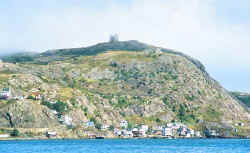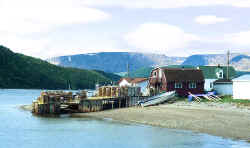 Departing
St. John's at last, we began to feel some of the urgency of the season,
as hurricanes were becoming more frequent to the south, and we knew that
the frequency of gales in this region increases substantially as the Equinox
approaches. Our plan would be to make miles when we could, and stop only
when we must. As we rounded the Avalon Peninsula, turning west for Cabot
Straits, a very stiff westerly convinced us to put in to St. Lawrence,
on the Burin Peninsula. The small village of St. Lawrence has a special,
although little known, place in our own nation's history.
Departing
St. John's at last, we began to feel some of the urgency of the season,
as hurricanes were becoming more frequent to the south, and we knew that
the frequency of gales in this region increases substantially as the Equinox
approaches. Our plan would be to make miles when we could, and stop only
when we must. As we rounded the Avalon Peninsula, turning west for Cabot
Straits, a very stiff westerly convinced us to put in to St. Lawrence,
on the Burin Peninsula. The small village of St. Lawrence has a special,
although little known, place in our own nation's history.
In a mid-winter storm in 1942, three old WWI destroyers were out-bound from Portland, ME for Argentia, Placentia Bay, Newfoundland. Just a couple of months after the attack on Pearl Harbor, the U.S. was not yet fully engaged in the war in Europe, but these old warships were being delivered to Newfoundland as part of our Lend-Lease effort to support Britain. Even in 1942 many naval ships were still without radar. Those that were so blessed enjoyed only relatively primitive and unreliable equipment. Electronic aids to navigation were for the most part limited to radio direction finding receivers and communications radios. Wartime measures, however, required radio silence as a defensive measure, as the approaches to Halifax and St. John's were prime hunting grounds for German U-boats preying on convoy's forming-up and departing from those ports for Britain and Russia.
In the swirling snows of the blizzard, the three antiquated four-stackers got forty miles off their course. Although they had received RDF signals from Cape Race, the bearings were mistrusted due to very poor signal propagation resulting from the storm. The lead destroyer, the Wilkes, (named for the leader of the 1839-41 U.S. Exploring Expedition) ran hard aground, nearly against the cliffs, between the villages of St. Lawrence and Lawn. Fully exposed to the force of the raging sea, the Wilkes, terribly damaged, managed to back off the rocks using the full power of her bunker-oil fueled steam engines. Still maintaining radio silence, she tried to alert the other two ships to the danger with signals flashed from her Aldis Lamp, but the other two in turn crashed against the treacherous coast. They were not so fortunate, and could not back off. Only a hundred yards separated the wrecks from the steep cliffs, and as the seas pounded their hulls on the rocks, the two venerable destroyers began to break apart.
As the seas continued to build throughout the storm darkened night, it was clear that desperate measures would be required at the first light of dawn. Attempts to launch a couple of boats failed as they were dashed to kindling against the sides of the wrecked ships. Cork life rafts were floated down onto the cliffs on lines, and a few crewmen managed to scramble up the escarpment, but the pounding surf parted the retrieval lines on the rafts, and they could not be returned to the ships. Others tried to swim for the cliffs. Covered in heavy bunker oil, many simply were dashed against the cliffs, unable to scramble high enough for safety. But one of the early raft crew made it to the top and managed to summon help from the nearby village of St. Lawrence.
 Villagers
from St. Lawrence and Lawn rushed to assist the imperiled sailors. Risking
their own lives, the fishermen and miners from these villages scaled the
cliffs to rescue 180 of the Americans. Though not trained as mountaineers,
the villagers used their skills as seamen and miners to rig lines over
the edge, in some cases using horses and Newfoundland ponies that worked
the mines to haul victims up the rock face. They cared for the injured
and hypothermic sailors as best they were able, in most cases in their
own homes. One Black mess steward was forever grateful that they did so
without any of the prejudice that he still encountered in his own country.
As an expression of their gratitude, the Americans built a hospital in
the town, and it is still in use today. The tragic irony is that for much
of the 20th century the town's mine was one of the few sources in the
world of fluorspar, a radioactive mineral. Many of the rescuers would
eventually die prematurely from cancers related to the radiation they
inhaled and absorbed at work in the mine. For most of them, that death
would come in the hospital built in gratitude for their wartime heroism.
Villagers
from St. Lawrence and Lawn rushed to assist the imperiled sailors. Risking
their own lives, the fishermen and miners from these villages scaled the
cliffs to rescue 180 of the Americans. Though not trained as mountaineers,
the villagers used their skills as seamen and miners to rig lines over
the edge, in some cases using horses and Newfoundland ponies that worked
the mines to haul victims up the rock face. They cared for the injured
and hypothermic sailors as best they were able, in most cases in their
own homes. One Black mess steward was forever grateful that they did so
without any of the prejudice that he still encountered in his own country.
As an expression of their gratitude, the Americans built a hospital in
the town, and it is still in use today. The tragic irony is that for much
of the 20th century the town's mine was one of the few sources in the
world of fluorspar, a radioactive mineral. Many of the rescuers would
eventually die prematurely from cancers related to the radiation they
inhaled and absorbed at work in the mine. For most of them, that death
would come in the hospital built in gratitude for their wartime heroism.
That tragedy and the heroism of modest Newfoundlanders sixty years ago brings me to today, in this time, in this present tragedy. On our way out of St. Lawrence in a fog so thick it could be plowed, we heard on the CBC that the World Trade Center had been destroyed and thousands of Americans as well as Canadians, together with many other nationalities, had been slaughtered in the name of politics and religion. Newfoundlanders have not been strangers to war and senseless slaughter. Every village in Newfoundland still honors those who died in both world wars, and in particular they do not forget the horrendous single day loss of much of the entire Royal Newfoundland Regiment at Beaumont Hamel during the First World War. Many villages lost sons from every family on that single day.
It was people who understood loss of this magnitude who stepped forward on September 11, 2001 to accept into their homes thousands of airline passengers stranded when seventy aircraft were compelled to land in Newfoundland. Because of those old lend-lease bases, Newfoundland still has airstrips capable of landing large jet liners in numbers far in excess of any usual ratio to their population. Nearly twenty thousand stranded passengers were accommodated at those same bases at Stephenville and Gander, as well as the modern international airport at St. John's. The population of Gander, about 6,500, was doubled by a like number of passengers. At the old Lend-lease bases, in the town stadia, and in private homes, people from around the world who had been caught up in the madness were billeted, fed and entertained by Newfoundlanders. Countless interviews of these travelers testified that nowhere can one find more friendly and helpful people than in Newfoundland, and we had noticed the same during both last season's cruise and this voyage.
It
is puzzlement to us that there are not more American boats cruising Newfoundland.
Stunning scenery, empty anchorages, free wharves in most villages, history,
and a genuine welcome by the indigenous population are all the things
that most of us who cruise seek, but fail to find. These people have a
strong connection and maintain close ties to New England, based in large
part on the rich tradition of the Grand Bank and Labrador fisheries, and
they are very grateful when Americans choose of their own accord to visit
them. We have never been more welcomed. With the loss of their primary
fishery, Newfoundland's economy has been problematic at best. They welcome
the few cruiser dollars they receive, and give more than fair value in
return. From the Gulf of Maine distances are not extreme, and once one
has mastered that Fundy fog,
Newfoundland is well within many cruisers' ability. As they would say here in Newfoundland, "Yes, Bye'!"
We have only explored a few of the thousands of fjords, bay, and inlets Newfoundland offers cruisers. Our plan is to spend June through October of 2005 cruising these waters.